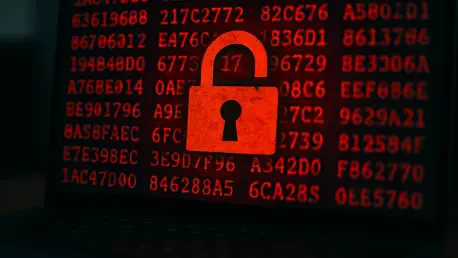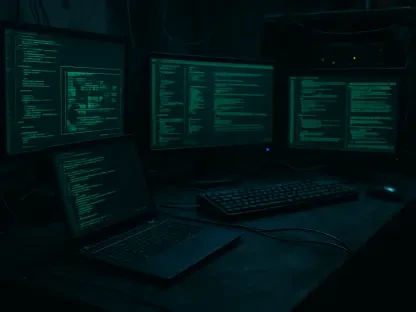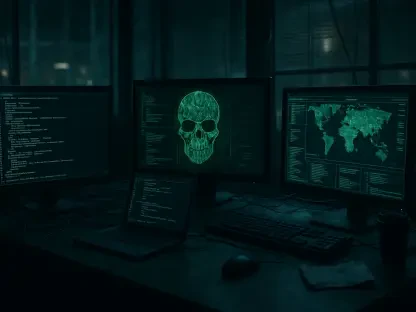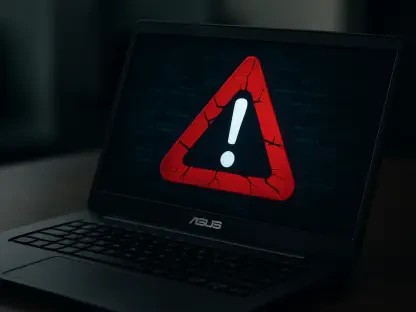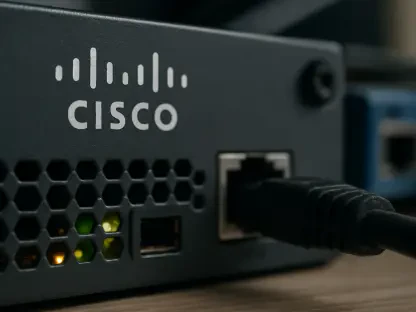Introduction to a Growing Cyber Threat
In 2025, the cybersecurity landscape faces an alarming challenge as a high-severity zero-day flaw in Broadcom’s VMware Tools and VMware Aria Operations, identified as CVE-2025-41244, has been actively exploited by sophisticated threat actors. This vulnerability, with a CVSS score of 7.8, allows local non-administrative users to escalate privileges to root level on affected virtual machines, posing a severe risk to organizations worldwide. The U.S. Cybersecurity and Infrastructure Security Agency (CISA) has flagged this issue in its Known Exploited Vulnerabilities catalog, signaling an urgent need for action as exploitation has been ongoing for months.
The stakes are incredibly high, with evidence pointing to China-linked threat actors, such as the group tracked as UNC5174 by Google Mandiant, leveraging this flaw for unauthorized access. This scenario underscores a broader trend of state-sponsored and financially motivated attackers targeting critical software platforms. The following guide outlines essential best practices to mitigate these risks and safeguard systems from such advanced persistent threats.
This discussion will focus on understanding the nature of the vulnerability, the importance of rapid response, and actionable strategies for protection. By adopting these best practices, organizations can strengthen their defenses against zero-day exploits and minimize the potential for catastrophic breaches in virtualized environments.
Why Immediate Action on Zero-Day Flaws is Essential
Zero-day vulnerabilities like CVE-2025-41244 represent a critical danger because they are exploited before vendors can release patches, leaving systems defenseless during the initial attack window. In the case of this VMware flaw, attackers can gain root access on virtual machines managed by Aria Operations with SDMP enabled, potentially compromising entire infrastructures. Such privilege escalation opens the door to data theft, system disruption, and further network infiltration.
Delaying action against these threats can result in significant financial losses, reputational damage, and regulatory penalties, especially for organizations handling sensitive data. The involvement of sophisticated actors, possibly state-sponsored, amplifies the risk, as their objectives may include espionage or long-term persistence within targeted networks. Proactive measures are vital to disrupt these attack chains before irreparable harm occurs.
Responding swiftly offers multiple benefits, including preserving system integrity and maintaining trust with stakeholders. By prioritizing vulnerability management, businesses can prevent unauthorized access and protect critical assets. This urgency is not just a technical necessity but a strategic imperative to stay ahead of adversaries who exploit unpatched flaws with alarming efficiency.
Understanding the VMware Flaw and Its Exploitation
CVE-2025-41244 affects VMware Tools and VMware Aria Operations, enabling local users without administrative privileges to execute code in privileged contexts, such as root access. This high-severity flaw, rated at 7.8 on the CVSS scale, has been under active exploitation since at least mid-2025, well before Broadcom issued a patch. Cybersecurity experts at NVISO Labs, who identified the issue during an incident response engagement earlier this year, described the exploitation process as alarmingly simple.
The ease of exploiting this vulnerability heightens its danger, as attackers require minimal technical barriers to achieve significant system control. While specific details about post-exploitation payloads remain undisclosed, the potential for malicious actors to deploy ransomware, steal data, or establish persistent backdoors is a pressing concern. Organizations relying on virtualization must recognize the gravity of this flaw’s impact on their operational security.
CISA’s inclusion of this vulnerability in its catalog emphasizes the real-world threat it poses, with confirmed instances of active attacks. For federal agencies and private entities alike, understanding the technical scope of this issue is the first step toward effective mitigation. Awareness of how such flaws operate provides a foundation for deploying targeted defenses against similar exploits in the future.
Attribution to China-Linked Threat Actors
During an incident response investigation in early 2025, NVISO Labs uncovered evidence linking the exploitation of CVE-2025-41244 to UNC5174, a China-linked threat actor tracked by Google Mandiant. This group’s involvement suggests a high level of sophistication, potentially indicative of state-sponsored motives, though definitive intent remains unconfirmed. Their targeting of VMware systems highlights a strategic focus on critical infrastructure and virtualization platforms.
The attribution to UNC5174 raises concerns about the broader implications of such attacks, including the possibility of espionage or preparation for larger-scale cyber operations. Cybersecurity reports indicate that this actor has a history of exploiting unpatched vulnerabilities to gain deep access to targeted environments. This pattern of behavior necessitates heightened vigilance among organizations using affected software.
Understanding the adversary’s tactics is crucial for tailoring defensive measures. While the full scope of UNC5174’s objectives in this campaign is unclear, their ability to weaponize a zero-day flaw underscores the need for robust threat intelligence and monitoring. Staying informed about such actors enables organizations to anticipate potential attack vectors and reinforce their security posture accordingly.
Broader Trends in Software Exploitation
Beyond the VMware flaw, CISA has also highlighted a critical eval injection vulnerability in XWiki, a collaborative platform, which has been exploited for malicious purposes like cryptocurrency mining, as reported by VulnCheck. This separate issue demonstrates how threat actors target a wide range of software to achieve diverse objectives, from financial gain to system compromise. The variety of exploited platforms reveals the expansive attack surface modern organizations must defend.
The exploitation of XWiki for deploying cryptocurrency miners showcases a financially motivated agenda, contrasting with the privilege escalation goals seen in the VMware attacks. This diversity in malicious intent illustrates that adversaries adapt their strategies based on the vulnerabilities at hand, exploiting any unpatched flaw for maximum impact. Such trends emphasize the importance of comprehensive security across all software environments.
These parallel alerts from CISA serve as a reminder that zero-day exploits are not isolated incidents but part of a larger ecosystem of cyber threats. Organizations must adopt a holistic approach to vulnerability management, addressing risks in both virtualization tools and collaborative platforms. Recognizing these broader patterns helps in building resilience against evolving attack methodologies.
Practical Best Practices for Mitigation
To combat the risks posed by CVE-2025-41244 and similar zero-day flaws, organizations must prioritize immediate patching of affected VMware Tools and VMware Aria Operations instances. Broadcom has released updates to address this vulnerability, and applying these fixes without delay is critical to closing the exploitation window. Federal agencies, in particular, should adhere to CISA’s mitigation deadline set for November 20 of this year, while private entities are urged to act with equal urgency.
Implementing robust monitoring and logging mechanisms is another essential practice to detect unauthorized access or privilege escalation attempts in real time. By maintaining detailed audit trails, security teams can identify suspicious activities early and respond before significant damage occurs. This proactive stance is especially important given the simplicity of exploiting flaws like the one in question, which can evade traditional defenses.
Finally, fostering a culture of cybersecurity awareness and preparedness is vital for long-term protection. Regular training for staff on recognizing phishing attempts and other entry points for attackers can prevent initial compromises that lead to local access exploitation. Additionally, conducting routine vulnerability assessments and engaging with threat intelligence resources ensures that defenses remain aligned with the latest attack trends, safeguarding systems against both known and emerging risks.
Reflecting on the Path Forward
Looking back, the active exploitation of VMware’s zero-day flaw by China-linked actors like UNC5174 revealed critical gaps in cybersecurity readiness that many organizations struggled to address. The parallel exploitation of platforms like XWiki for financial gain further exposed the diverse motives driving cyber adversaries. These incidents served as stark reminders of the relentless pace at which threats evolved during this period.
Moving ahead, the focus must shift toward building adaptive security frameworks that can withstand zero-day exploits through continuous improvement. Investing in automated patching solutions and advanced threat detection tools emerged as a necessary step to outpace attackers. Organizations that embraced these technologies positioned themselves to better handle unexpected vulnerabilities.
Ultimately, collaboration between public and private sectors stood out as a key takeaway from these challenges. Sharing threat intelligence and best practices became instrumental in creating a unified front against sophisticated actors. By committing to these actionable strategies, businesses and agencies could chart a more secure course for the years ahead, ensuring resilience in an increasingly hostile digital landscape.
